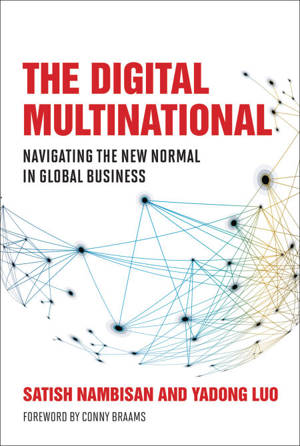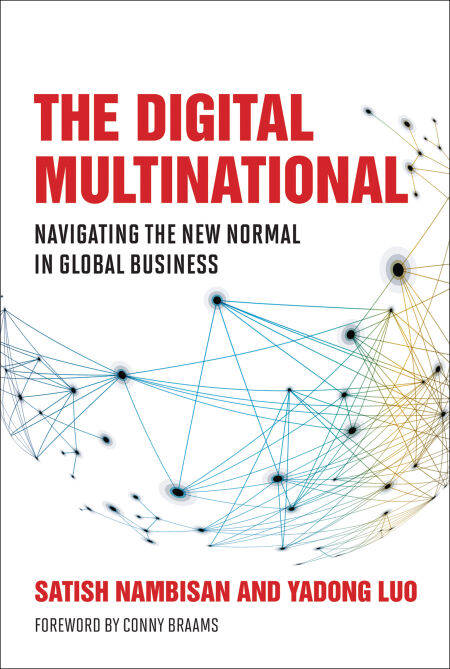
Bedankt voor het vertrouwen het afgelopen jaar! Om jou te bedanken bieden we GRATIS verzending (in België) aan op alles gedurende de hele maand januari.
- Afhalen na 1 uur in een winkel met voorraad
- In januari gratis thuislevering in België
- Ruim aanbod met 7 miljoen producten
Bedankt voor het vertrouwen het afgelopen jaar! Om jou te bedanken bieden we GRATIS verzending (in België) aan op alles gedurende de hele maand januari.
- Afhalen na 1 uur in een winkel met voorraad
- In januari gratis thuislevering in België
- Ruim aanbod met 7 miljoen producten
Zoeken
The Digital Multinational E-BOOK
Navigating the New Normal in Global Business
Satish Nambisan, Yadong Luo
€ 29,52
+ 29 punten
Uitvoering
Omschrijving
How multinational companies can use digital technology to compete in a world where business is driven by the forces of both globalization and deglobalization.
Digital technology has put globalization on steroids; multinational companies now account for one-third of world GDP and one-fourth of world employment. And yet complicating this story of unchecked global capitalism are two contradictory forces. Even as advances in digital technology enable borderless markets, a new nationalism has emerged, reviving protectionism and railing against digital colonialism. In The Digital Multinational, management experts Satish Nambisan and Yadong Luo examine how companies can adopt a dual strategy to cope with this new normal: harnessing the power of digital technology while adapting to the geopolitical realities of particular markets.
Key to success, Nambisan and Luo explain, is the notion of tight and loose coupling to characterize the relationship of the digital multinational to its global partners and subsidiaries. Identifying the tightness-looseness requirements of global business connectivity leads to successful business strategy. Drawing on real-world examples that include Burberry’s entrance into the Chinese market, Unilever’s AI-powered global talent marketplace, and the Vocal for Local movement in India, they develop a typology of global business contexts; discuss digital strategies for entering new markets, establishing digital platforms, managing globally dispersed activities, and pursuing innovation; and explain how these strategies can be part of a business leader’s toolkit. The Digital Multinational is an essential guide to competing in a business world driven by both globalization and deglobalization.
Digital technology has put globalization on steroids; multinational companies now account for one-third of world GDP and one-fourth of world employment. And yet complicating this story of unchecked global capitalism are two contradictory forces. Even as advances in digital technology enable borderless markets, a new nationalism has emerged, reviving protectionism and railing against digital colonialism. In The Digital Multinational, management experts Satish Nambisan and Yadong Luo examine how companies can adopt a dual strategy to cope with this new normal: harnessing the power of digital technology while adapting to the geopolitical realities of particular markets.
Key to success, Nambisan and Luo explain, is the notion of tight and loose coupling to characterize the relationship of the digital multinational to its global partners and subsidiaries. Identifying the tightness-looseness requirements of global business connectivity leads to successful business strategy. Drawing on real-world examples that include Burberry’s entrance into the Chinese market, Unilever’s AI-powered global talent marketplace, and the Vocal for Local movement in India, they develop a typology of global business contexts; discuss digital strategies for entering new markets, establishing digital platforms, managing globally dispersed activities, and pursuing innovation; and explain how these strategies can be part of a business leader’s toolkit. The Digital Multinational is an essential guide to competing in a business world driven by both globalization and deglobalization.
Specificaties
Betrokkenen
- Auteur(s):
- Uitgeverij:
Inhoud
- Aantal bladzijden:
- 264
- Taal:
- Engels
- Reeks:
Eigenschappen
- Productcode (EAN):
- 9780262367554
- Verschijningsdatum:
- 14/02/2022
- Uitvoering:
- E-book
- Beveiligd met:
- Adobe DRM
- Formaat:
- ePub

Alleen bij Standaard Boekhandel
+ 29 punten op je klantenkaart van Standaard Boekhandel
Beoordelingen
We publiceren alleen reviews die voldoen aan de voorwaarden voor reviews. Bekijk onze voorwaarden voor reviews.









